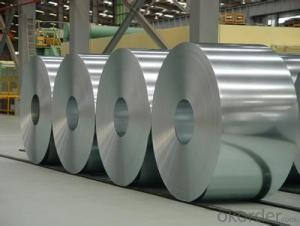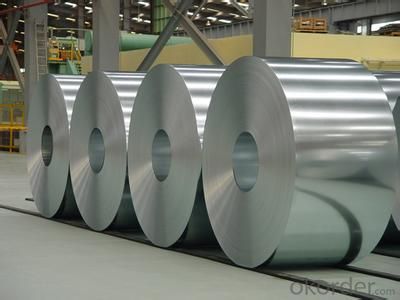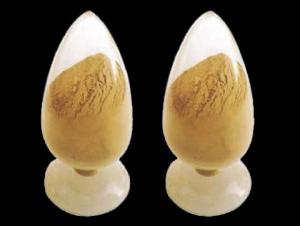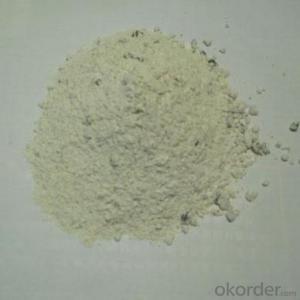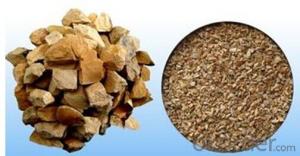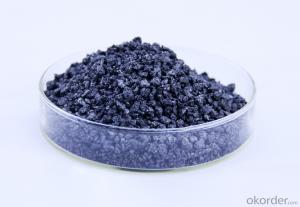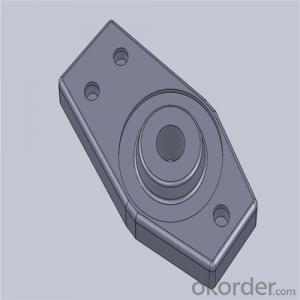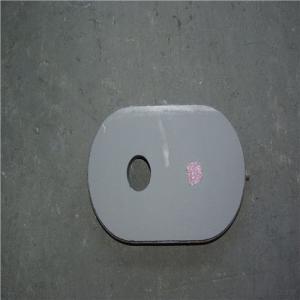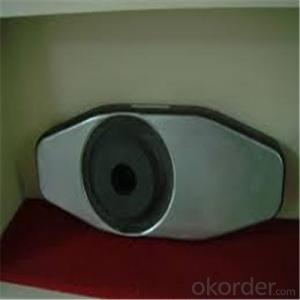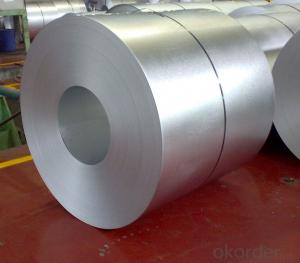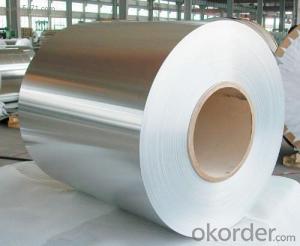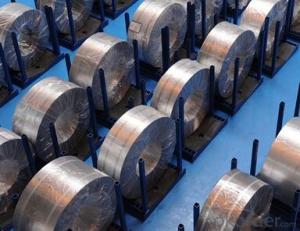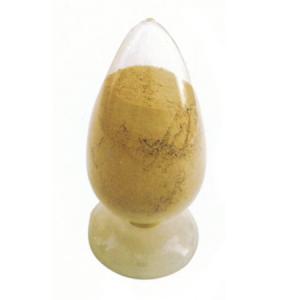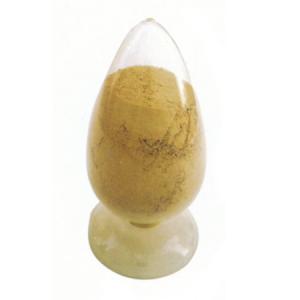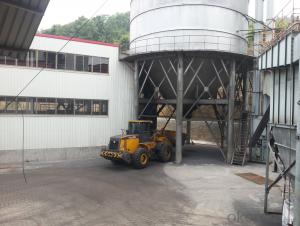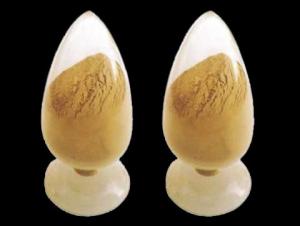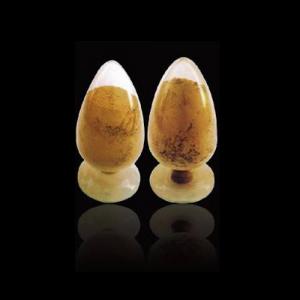Monolithic Refractories Hot-Dip Aluzinc Steel Building Roof Walls in Best Price Best Quality
- Loading Port:
- China main port
- Payment Terms:
- TT or LC
- Min Order Qty:
- 50 m.t.
- Supply Capability:
- 10000 m.t./month
OKorder Service Pledge
OKorder Financial Service
You Might Also Like
Hot-dip Aluzinc Steel Building Roof Walls in Best Price Best Quality
1. Description of the Hot-dip Aluzinc Steel:
Hot-dip aluzinc steel structure is composed of aluminum-zinc alloy, consisting of 55% aluminum, 43% zinc and 2% at 600 ℃ silicon solidification temperature and composition, the entire structure is made of aluminum - iron - silicon - zinc, to form a dense quaternary crystals an alloy.
Hot-dip aluzinc steel has many excellent features: strong corrosion resistance, is three times the pure galvanized sheet; zinc surface with beautiful flowers, can be used as a building outside board.
Applications of hot-dip aluzinc steel:
1)Building: roof, walls, garages, soundproof walls, pipes and modular housing.
2)Automotive: muffler, exhaust pipes, wiper accessories, fuel tank, truck boxes, etc.
3)Appliances: refrigerator back, gas stove, air conditioners, microwave oven, LCD frame, 4)CRT-proof band, LED backlight, electrical cabinets, etc.
5)Farm: barn, sheds, silos, piping and other greenhouse.
2.Main Features of the Hot-dip Aluzinc Steel:
• Excellent corrosion resistance
• High temperature oxidation resistance
• Good manufacturability
•Beautiful appearance
•Surface coating
•Cost-effective
3.Hot-dip Aluzinc Steel Images
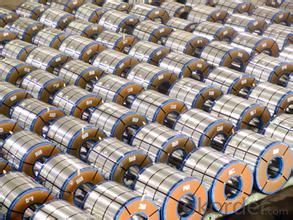

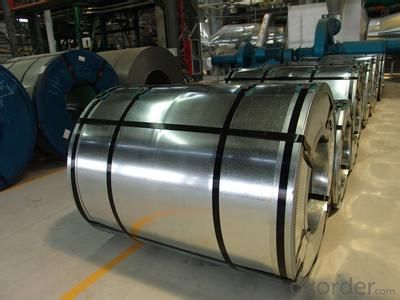
4.Hot-dip Aluzinc Steel Specification
AVAILABLE SPECIFICATION
HOT-DIP ALUZINC STEEL COILS | |
THICKNESS | 0.16mm-3.5mm |
WIDTH | 1250mm MAX |
COATING MASS | 30g/ m2-185 g/ m2 |
SPANGLE | Regular Spangle, Minimized Spangle, Zero Spangle |
SURFACE TREATMENT | Chromated / non-chromated, Oiled / non-oiled, Anti Finger Print |
COIL INNER DIAMETER | 508mm or 610mm |
HOT-DIP ALUZINC STEEL COILS | |||
COMMERCIAL QUALITY | ASTM A792M-06a | EN10327-2004 | JIS G 3321:2010 |
STRUCTURE STEEL | SS GRADE 230 SS GRADE 255 SS GRADE 275 SS GRADE 340 SS GRADE 550 | S220GD+AZ S250GD+AZ S280GD+AZ S320GD+AZ S350GD+AZ S550GD+AZ | SGLC400 SGLC440 SGLC490 SGLC570 |
5.FAQ of Hot-dip Aluzinc Steel
We have organized several common questions for our clients,may help you sincerely:
1.What advantages does your company have?
Cement : Annual capacity of 400 million tons, No. 1 in the world
Fiberglass: Annual capacity of 1 million tons fiberglass, No. 1 in the world.
Composite Materials — Rotor Blade: Annual production capacity of 15,000 pieces, No.1 in China, Top3 worldwide
Light Weight Building Materials: Annual capacity of 1.65 billion square meters of gypsum board, No. 1 in the world.
Commercial concrete: Annual capacity of 0.35 billion cubic meters, No. 1 in the world.
Refractory Material: Annual capacity of 40,000 tons casting refractory, No.1 in the world.
2.What advantages do your products have?
Firstly, our base material is of high quality, Their performance is in smooth and flat surface,no edge wave ,good flexibility.
Secondly, high quality zinc ingoats, 97.5% zinc,1.5% silicon,1% others, the same zinc coating measured by metal coating thickness or by zinc weight
Thirdly, high precision: Tolerance strictly according to ASTM or JISG standard even more rigid.
We have full stes of testing equipment(for t best, cupule,chromatism,salt spray resistance, etc) and professional engineers.
- Q: What are the main factors affecting the thermal expansion of monolithic refractories?
- The thermal expansion of monolithic refractories is influenced by various factors. These factors comprise the type of refractory material, the temperature range, the chemical composition, and the physical structure of the refractory. To begin with, the thermal expansion behavior of a refractory is significantly determined by its type of material. Different types of refractories, such as alumina-based, silica-based, and magnesia-based refractories, possess varying coefficients of thermal expansion (CTE). For instance, alumina-based refractories generally exhibit a lower CTE in comparison to silica-based refractories. Consequently, the choice of refractory material holds great influence over its thermal expansion characteristics. Secondly, the thermal expansion of a refractory is affected by the temperature range to which it is exposed. As the temperature rises, the refractory material expands due to the absorption of thermal energy. However, different refractories demonstrate different expansion behaviors depending on temperature. Some refractories may exhibit a linear or near-linear expansion with temperature, while others may display non-linear or step-wise expansion. Hence, the temperature range of operation is a critical factor in determining the suitability of a refractory for a specific application. The chemical composition of the refractory also has an impact on its thermal expansion. The presence of various chemical elements and compounds in the refractory material can influence its expansion behavior. For instance, the addition of specific oxides, like magnesia or zirconia, can modify the CTE of the refractory. Similarly, impurities or variations in the chemical composition can introduce discrepancies in expansion characteristics among refractories of the same type. Lastly, the physical structure of the refractory, encompassing factors such as porosity, density, and microstructure, can influence thermal expansion. The existence of open or closed pores within the refractory can affect its ability to expand uniformly under thermal stress. The density of the refractory also plays a role, as denser refractories tend to have lower thermal expansion. Moreover, the microstructure, including grain size and orientation, can impact the overall expansion behavior of the refractory. To conclude, the primary factors influencing the thermal expansion of monolithic refractories include the type of refractory material, temperature range, chemical composition, and physical structure. A comprehensive understanding of these factors is crucial in selecting the appropriate refractory for a specific application to ensure optimal performance and durability.
- Q: How do monolithic refractories contribute to the overall efficiency of ladle transfer processes?
- Monolithic refractories play a crucial role in enhancing the overall efficiency of ladle transfer processes. These refractories are made of a single, homogeneous material, which allows for easy installation and maintenance. This feature significantly reduces downtime during the ladle transfer process, resulting in increased productivity. One way monolithic refractories contribute to efficiency is through their high thermal conductivity. Ladle transfer processes involve the transfer of molten metal, which generates immense heat. Monolithic refractories have excellent heat resistance, ensuring that they can withstand the extreme temperatures of the molten metal. This property prevents refractory failure and prolongs the lifespan of the ladle, leading to more efficient and uninterrupted ladle transfer operations. Additionally, monolithic refractories offer superior corrosion resistance. The corrosive nature of molten metal can cause significant damage to ladles over time. However, monolithic refractories are designed to withstand chemical attacks from molten metal, preventing the degradation of the ladle's integrity. As a result, ladles lined with monolithic refractories have a longer lifespan and require less frequent replacement, leading to cost savings and improved efficiency. Furthermore, the ability of monolithic refractories to conform to complex shapes and designs is another contributing factor to the efficiency of ladle transfer processes. Ladles come in various sizes and shapes, and the use of monolithic refractories allows for customized linings that perfectly fit the ladle's dimensions. This precise fit minimizes heat loss and maximizes energy efficiency during ladle transfer processes. Moreover, monolithic refractories offer excellent mechanical strength and resistance to thermal shock. Ladle transfer processes involve the handling and movement of ladles, which can subject refractories to mechanical stresses. The outstanding mechanical properties of monolithic refractories ensure their durability and prevent cracking or spalling, reducing the risk of refractory failure and improving the efficiency of ladle transfer operations. In summary, monolithic refractories contribute to the overall efficiency of ladle transfer processes by providing high thermal conductivity, corrosion resistance, precise lining fit, and excellent mechanical properties. These refractories enhance the ladle's durability, reduce downtime, and improve energy efficiency, resulting in cost savings and increased productivity in the steelmaking industry.
- Q: What are the challenges faced in the application of monolithic refractories?
- The application of monolithic refractories presents several challenges. Firstly, a major hurdle is the correct installation of these refractories. Unlike traditional brick refractories that can be easily stacked, specialized skills and techniques are required for the proper application of monolithic refractories. The consistency and workability of the refractory material must be carefully controlled, and specialized equipment such as gunning machines or vibrating tools are often necessary for the installation process. Another challenge lies in selecting the appropriate monolithic refractory material for a specific application. There are various types of monolithic refractories available, each with its own unique properties and suitability for different environments. Choosing the wrong type of refractory material can lead to premature failure and expensive repairs. Therefore, it is crucial to understand the operating conditions, including temperature, chemical exposure, and mechanical stress, in order to select the most suitable monolithic refractory material. Additionally, monolithic refractories are prone to thermal shock and erosion due to their composition and method of application. They are typically made from fine powders that are mixed with water or other binding agents to form a paste. This paste is then applied and dried to create a solid refractory lining. However, during the heating and cooling cycles, monolithic refractories can experience thermal expansion and contraction, resulting in cracks and spalling. Furthermore, chemical reactions occurring in certain industrial processes can cause chemical attack and erosion of the refractory lining, reducing its lifespan. Furthermore, the maintenance and repair of monolithic refractories can also pose a challenge. Unlike brick refractories that can be easily replaced, repairing monolithic refractories often requires skilled personnel and specialized techniques. The damaged area must be removed, and a new layer of refractory material must be applied, ensuring proper bonding and compatibility with the existing lining. This process can be time-consuming and costly, especially in high-temperature applications where extended downtime can result in significant production losses. In conclusion, the application of monolithic refractories presents challenges in terms of proper installation techniques, material selection, susceptibility to thermal shock and erosion, and complex maintenance and repair procedures. Overcoming these challenges requires expertise, careful planning, and a comprehensive understanding of the specific operating conditions and requirements for each application.
- Q: What are the advancements in monolithic refractory technology for the iron and steel industry?
- There have been significant advancements in monolithic refractory technology for the iron and steel industry in recent years. Monolithic refractories are a type of heat-resistant material used to line the walls and floors of high-temperature industrial processes, such as those involved in iron and steel production. One of the key advancements in monolithic refractory technology is the development of new and improved materials. Traditional refractory materials, such as firebricks, have been replaced by more advanced materials like castables and gunning mixes. These new materials offer superior performance in terms of thermal conductivity, thermal shock resistance, and erosion resistance. They can withstand higher temperatures and can be applied more efficiently, resulting in improved process efficiency and reduced downtime for maintenance. Another important advancement is the use of advanced additives in monolithic refractories. These additives can enhance the properties of the refractory material, such as increasing its resistance to corrosion and erosion. They can also improve the bond between the refractory and the substrate, ensuring a longer lifespan for the lining. Furthermore, advancements in monolithic refractory technology have led to the development of innovative installation techniques. For instance, shotcreting, a process that involves spraying the refractory material onto the surface, has gained popularity due to its efficiency and ability to provide a uniform lining. Similarly, the use of gunning machines, which pump the refractory material at high velocity, has improved the speed and accuracy of installation. Moreover, there have been advancements in the design of monolithic refractories specifically tailored for different applications in the iron and steel industry. Refractories for blast furnaces, ladles, tundishes, and other critical equipment have been optimized to withstand the unique challenges and harsh conditions of these processes. The development of specialized monolithic refractories has resulted in increased productivity, reduced energy consumption, and improved product quality in the iron and steel industry. In conclusion, advancements in monolithic refractory technology for the iron and steel industry have brought about improved materials, advanced additives, innovative installation techniques, and specialized designs. These advancements have significantly enhanced the performance, durability, and efficiency of refractory linings in high-temperature industrial processes. As a result, the iron and steel industry can benefit from increased productivity, reduced downtime, and improved product quality.
- Q: How do monolithic refractories contribute to the reduction of downtime in iron and steel plants?
- Monolithic refractories contribute to the reduction of downtime in iron and steel plants by providing superior thermal insulation and resistance to high temperatures, reducing the risk of equipment failure and unplanned shutdowns. Their ability to withstand extreme conditions, such as molten metal and slag, allows for extended operational periods without frequent maintenance or replacement. Additionally, monolithic refractories offer quick and easy installation, repair, and maintenance, minimizing the time required for downtime and ensuring a more efficient and productive operation in iron and steel plants.
- Q: How do monolithic refractories help in improving the quality of iron and steel products?
- Monolithic refractories play a crucial role in improving the quality of iron and steel products in several ways. Firstly, these refractories are used to line the furnaces and other high-temperature equipment in the iron and steel industry. By providing a high level of thermal insulation, monolithic refractories help maintain a consistent and controlled temperature inside the furnace, ensuring efficient heating and melting of metals. The use of monolithic refractories also helps in reducing heat loss, thereby increasing the energy efficiency of the process. This not only saves costs but also minimizes the environmental impact associated with high energy consumption. Additionally, the insulation properties of monolithic refractories contribute to the reduction of thermal stresses within the furnace, preventing cracks and other structural damages that can affect the quality of the iron and steel products. Moreover, monolithic refractories possess excellent resistance to chemical reactions, corrosion, and erosion caused by molten metals, slag, and other harsh substances. This resistance helps to maintain the integrity of the refractory lining, preventing contamination of the iron and steel products by unwanted impurities. As a result, the quality of the final products, such as steel bars, sheets, or pipes, is improved, meeting the desired specifications and industry standards. Another advantage of monolithic refractories is their ability to provide a smooth and clean lining surface. This smoothness minimizes the adherence of slag, molten metal, and other by-products, reducing the risk of defects and ensuring a higher-quality finish for the iron and steel products. The clean lining surface also facilitates easy maintenance and cleaning, allowing for efficient and effective operations. In summary, monolithic refractories contribute significantly to the improvement of iron and steel product quality through their exceptional thermal insulation, resistance to chemical reactions, erosion, and corrosion, as well as their ability to provide a smooth and clean lining surface. By ensuring consistent temperatures, reducing heat loss, preventing structural damages, and maintaining a clean environment, monolithic refractories enhance the overall efficiency and integrity of the iron and steel production process, resulting in high-quality end products.
- Q: How are monolithic refractories installed in iron and steel production processes?
- Monolithic refractories are installed in iron and steel production processes by first preparing the surface, then applying the refractory material in a plastic or semi-plastic state. This can be done through various methods such as gunning, casting, ramming, or spraying. After the installation, the refractory material is allowed to cure and harden, forming a durable lining that can withstand high temperatures and harsh conditions in the production processes.
- Q: How do monolithic refractories resist corrosion and erosion in the iron and steel industry?
- To combat corrosion and erosion in the iron and steel industry, monolithic refractories are designed with a combination of composition and application techniques. Firstly, the composition includes high-quality raw materials like alumina, magnesia, and silica, which possess exceptional resistance to corrosion and erosion. For example, alumina can withstand high temperatures and chemical attacks, making it an ideal choice for protecting against the corrosive nature of the industry. Additionally, the application techniques used in installing monolithic refractories are crucial for their resistance. These techniques, such as gunning, ramming, or casting, ensure a tight and seamless bond between the refractory and the steel structure, reducing the chances of corrosion and erosion. Furthermore, monolithic refractories can be tailored to meet the specific needs of different parts of the iron and steel industry. For areas exposed to molten metal, refractories with high thermal conductivity and resistance to chemical attack are utilized. This customization enhances the refractory's effectiveness in resisting corrosion and erosion. Moreover, monolithic refractories often incorporate additives or binders to further enhance their resistance. These additives provide extra protection against chemical attacks from molten metal or corrosive gases, making the refractory even more durable in harsh conditions. In summary, monolithic refractories effectively resist corrosion and erosion in the iron and steel industry due to their composition, application techniques, customization, and the inclusion of additives. By combining these factors, these refractories ensure the longevity and efficiency of steel structures in the challenging environments of the industry.
- Q: How do monolithic refractories improve the efficiency of ladle and tundish drying systems?
- The efficiency of ladle and tundish drying systems can be greatly improved by incorporating monolithic refractories. These refractories play a vital role in the steel industry, specifically in the drying process of ladles and tundishes prior to casting molten steel. One key advantage of monolithic refractories lies in their ability to create a seamless lining devoid of joints or gaps. This characteristic ensures that the lining remains strong and resistant to heat loss during the drying process. By maintaining a uniform and continuous lining, monolithic refractories facilitate faster and more effective drying of ladles and tundishes. Moreover, monolithic refractories possess exceptional thermal insulation properties. They exhibit low thermal conductivity, which enables them to effectively retain heat and prevent its dissipation into the surroundings. This insulation capability promotes better heat retention within ladles and tundishes during drying, ultimately leading to quicker and more energy-efficient drying. Furthermore, monolithic refractories demonstrate superior resistance to thermal shock. The drying process subjects ladles and tundishes to rapid temperature changes, which can induce thermal stress and result in cracks or spalling of the lining. However, monolithic refractories exhibit high resistance to thermal shock, ensuring the durability and longevity of the lining. This resistance to thermal shock minimizes the need for frequent repairs or replacements, thereby enhancing the overall efficiency of ladle and tundish drying systems. Additionally, monolithic refractories exhibit good corrosion resistance. They are specifically designed to withstand the harsh conditions and corrosive environments that ladles and tundishes encounter during the drying process. This corrosion resistance helps maintain the integrity of the lining, preventing any degradation or damage that could potentially impact the efficiency of the drying systems. In conclusion, the incorporation of monolithic refractories into ladle and tundish drying systems enhances their efficiency by providing a seamless lining, excellent thermal insulation, resistance to thermal shock, and corrosion resistance. These properties contribute to faster drying times, energy savings, reduced maintenance needs, and increased equipment longevity.
- Q: How do monolithic refractories improve the durability of furnace linings?
- The durability of furnace linings is significantly enhanced by the unique characteristics and properties of monolithic refractories. Unlike traditional brick refractories, which are made up of individual bricks or tiles, monolithic refractories consist of a single, homogeneous structure. A key advantage of monolithic refractories is their ability to eliminate joints and seams, which are weak points in traditional brick refractories. These joints can lead to cracks and failures due to thermal expansion and contraction. In contrast, monolithic refractories are poured or gunned into place, creating a seamless lining that minimizes the potential for cracks. This seamless structure increases the durability of the lining and reduces its susceptibility to thermal stress. In addition, monolithic refractories exhibit excellent thermal shock resistance, which is crucial for furnace linings that experience rapid and extreme temperature changes. The monolithic structure allows for better heat transfer and distribution, preventing localized hotspots that can cause thermal shock and lining failure. This enhanced thermal shock resistance enables the furnace lining to withstand repeated heating and cooling cycles without significant damage, thus improving its overall durability. Furthermore, monolithic refractories offer superior resistance to erosion and corrosion. Furnace linings are often exposed to harsh chemicals, molten metals, and abrasive materials, which can cause erosion and corrosion over time. Monolithic refractories are specifically designed to resist these corrosive agents, protecting the lining from chemical attacks and physical wear. This resistance ensures a longer lifespan for the furnace lining and reduces the need for frequent repairs or replacements. Moreover, monolithic refractories possess better insulation properties compared to traditional brick refractories. They have lower thermal conductivity, meaning that heat transfer through the lining is minimized. This insulation property helps to maintain a more stable and uniform temperature within the furnace, reducing thermal stress on the lining and contributing to its longevity. To summarize, monolithic refractories enhance the durability of furnace linings by eliminating joints and seams, improving thermal shock resistance, providing erosion and corrosion resistance, and offering superior insulation properties. These materials are specifically engineered to withstand the extreme conditions inside furnaces, ensuring a longer lifespan for the lining and reducing maintenance costs in the long term.
Send your message to us
Monolithic Refractories Hot-Dip Aluzinc Steel Building Roof Walls in Best Price Best Quality
- Loading Port:
- China main port
- Payment Terms:
- TT or LC
- Min Order Qty:
- 50 m.t.
- Supply Capability:
- 10000 m.t./month
OKorder Service Pledge
OKorder Financial Service
Similar products
Hot products
Hot Searches
Related keywords
